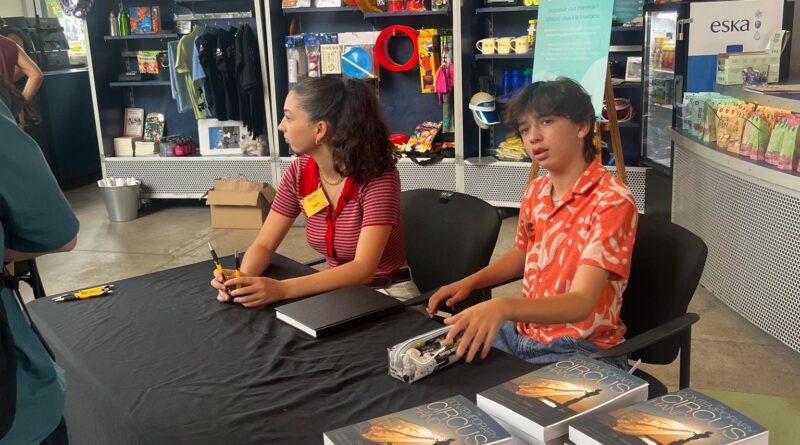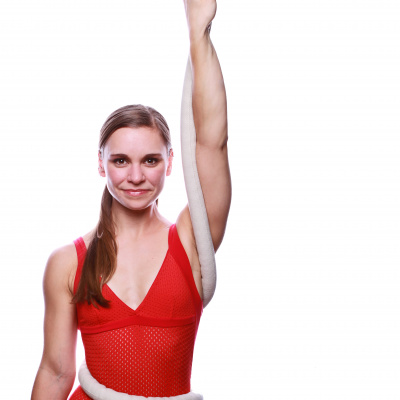Publishing Circus: An Interview with Thom Wall of Modern Vaudeville Press
As we all know, circus comes in many forms, and CircusTalk is dedicated to honoring them all: live performance, education, history, experimentation, research, and on and on! I’m always honored to write about circus from these varying angles, but one of my favorite things I do for the site is curate articles written by folks in the Circademic community. They write about their most recent academic research, theories, or interdisciplinary events. I usually stay behind the scenes, giving Circademic authors a little piece of our website stage… but this month’s article is a bit of a role reversal in order to serve the Circademic community.
I’ve interviewed my friend and colleague, Thom Wall, founder of Modern Vaudeville Press. Wall has niche expertise as a performer, academic, and publisher. Modern Vaudeville Press is known for its exhaustive research and ability to look at the circus industry from all angles—ensuring that accurate research is paired with a comprehensive, cultural context, thus making Modern Vaudeville Press a crucial leader in publishing circus. Here, Wall offers insights on how to compile all the fabulous research sitting on your desk (or desktop), edit it, print it, bind it, and get it into the hands and minds of the greater circus community. Enjoy! ~ Madeline Hoak
Madeline: Tell us about yourself and Modern Vaudeville Press.
Thom: I learned to juggle when I was ten years old. I checked Dave Finnigan’s The Complete Juggler out from my school library and learned everything I could… mostly just playing around in my backyard. Fast-forward fourteen years: from 2014 through 2019, I’m working for Cirque du Soleil as the mainstage juggling act in Totem. These days, I am an emcee for non-profit fundraisers and perform my solo show, On the Topic of Juggling, as a headlining act on Royal Caribbean Cruise Lines.
When I was on tour with Soleil, I got really bored. It’s hard to describe it any other way, honestly. I performed around 1,500 shows for them over five years and needed something to occupy my brain. I had a background in creative nonfiction writing from undergrad, and I decided it would be fun to work on a long-form writing project. My father is a retired physician, now working in Egyptology, and we decided to work on an article about the jugglers depicted in the tombs at Beni Hasan in Middle Egypt. That research led to investigations into Hellenistic jugglers and… suffice it to say, that little project snowballed into my first book, Juggling: From Antiquity to the Middle Ages.
A few years after I’d started, I shopped the nearly-completed manuscript around to a number of university presses – they showed some interest! I was thrilled. The deal I was offered, though, didn’t make much sense–a tiny cut of the sales after building their entire marketing plan. Their interest helped me understand that yes! this was a project with merit, but their terms, combined with their limited knowledge of the circus industry made it a difficult decision to make. I ultimately decided to learn about the publishing industry and get this project out however I could. That’s the origin of Modern Vaudeville Press. Juggling: From Antiquity to the Middle Ages was the company’s first publication.

I had no idea if we would ever publish a second book, but if we did, I knew that we’d offer our writers a better deal than the industry standard. We want authors to understand that this is a partnership. And so far? It’s worked out really well! Antiquity is now being used as a textbook at the University of California, and has been cited in a number of academic papers (including a book from one of the university presses that rejected that original manuscript!). Part of Antiquity was also reworked as a chapter for Under One Tent (Ben Yehuda Press, 2023).
I think fellow circus performers understand–sometimes when you’re told “no,” the best thing you can do is figure out a way to do it on your own. “Put up or shut up,” right? If the book is good, people will read it–irrespective of university affiliation. Since this project began, MVP has been featured in the Independent Book Publishers Association (IBPA)’s magazine The Independent about our partnerships with libraries. We have been invited to judge nonfiction book awards, and have also had several books win accolades within the independent publishing world. Our work has also been recognized by the International Jugglers’ Association with its Excellence in Education award.
Modern Vaudeville Press had its first physical book proof generated in 2018, and the release-ready version went on sale in 2019. We’ve been around for just over five years, and currently have 16 titles out. We also have 10 additional projects in the works at varying stages of completion underway–including translations of popular European texts. 2024 is going to be a big year for us—keep your eyes peeled!
Madeline: What makes a good Circademic book?
Thom: For me, a “good” Circademic book is written with accessibility in mind–but still holds up to an academic standard. It doesn’t have to be a “beach read,” but if you want to maximize a book’s impact, you need to make sure it’s approachable to circus performers on the road as well as Ph.D. academics.
One way to think about this is “inside the tent versus outside the tent.” How can you frame your research to be palatable–in both language and layout–and have content that is applicable to folks who do circus and those who think about circus? How can you write about circus in a way that brings people with no circus background into the fold by getting them to care rather than marvel at some spectacle? How can we shatter the false nostalgia that new cultural touchstones like The Greatest Showman reinforce?
Madeline: To me, the world of academia and practice often seem, at best, distant, at worst, at odds. How can publications help bridge this gap?
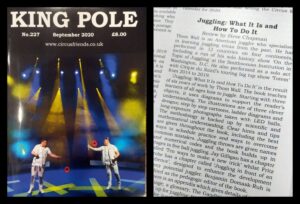
Thom: Many people pursue the circus arts—through a formal program or on their own—because “traditional” schooling didn’t appeal to them. I understand that! And that’s why we work to make sure Modern Vaudeville Press’s titles are accessible to people who live and work outside of academia–to touch the folks who are actually engaging with the disciplines we talk about. There are some incredible texts being published right now—Routledge’s 360 Circus comes to mind—that really have a lot to say, but are written in a way that folks without an advanced degree will have a hard time parsing. I’m thrilled that these books exist, but their (important!) approach does contribute to the distance you’re referring to.
Is there an easy solution? I’m not sure. But the place we’ve decided to start working on it is through the voice of our books themselves.
Madeline: I understand that you get a lot of manuscript submissions. How do you pick what you’re going to work on next?
Thom: Not all research is ready for print or right for Modern Vaudeville Press. We have turned down a number of proposals. The honest truth is that not everything folks send us is ready for print and often needs a lot of development and workshopping–the research is always interesting, but it’s not always framed in the most productive way.
Our biggest bottleneck is time. I lead an extremely small team that helps make our work possible, bringing colleagues in on various projects and outsourcing what “busywork” we can. I handle all of the copyediting, layout, design, and production myself in order to keep the price of books affordable. Realistically, that means that I’m often working on editing projects backstage in a theater or in my cabin on cruise ship contracts, underwriting the costs related to publishing our titles with my show fee. As we grow as a company, I’m excited to expand our team to help bring more great books to our readership.
We’re already seeing some momentum through the readership we’re cultivating. The bet I’ve been wagering on for several years now is that there’s not only a market for these titles, but an important gap within our community’s circus library that wants to be filled—and that bet seems to be paying off. At the moment, we have just over 10,000 copies of our books in circulation.
That said, there are interesting projects that have crossed my desk, but to which I couldn’t give the necessary time. It can be a lot of work to bring a book to life, and the realities of performing for a living and working with a skeleton crew can make it difficult to produce all of the books we want to. As with everything, it’s a learning process–and sometimes projects we initially think are a good fit for our catalog don’t end up working out.
In fact, we’ve had to cancel projects that were in-the-works for years a few times, which has always been a big loss in terms of time and energy.
In one instance, an author and I disagreed on how to talk about the display of underprivileged performers in what were essentially “Human Zoo” settings. The research was exceptional, but the framing was problematic with regards to how it talked about class politics, racial dynamics, and substance abuse; often writing from an exotifying and objectifying viewpoint that–intentionally or not–dehumanized the performers the author was writing about. (If you’re interested in some books that touch on these issues, I recommend Human Zoos by Blanchard et al, 2009; and Magic’s Reason by Jones, 2017.) The project ended up being something no one in our organization was comfortable backing, and we parted ways. The book ended up being published through a different company—and was wonderful in many ways, but it lacked the critical analysis that is needed to drive conversations within our industry forward. It didn’t line up with our mission.
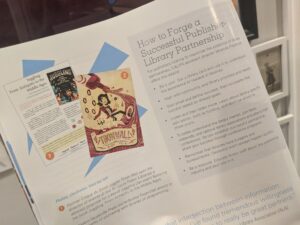
Another project we passed on was the history of a European animal-training family around the turn of the century. Again, the research was incredible; its sources included original copies of every contract this family had ever signed stateside. They arrived in the 1900s, and worked through both World Wars… and the salaries represented in the contracts fluctuated in value, dropping to a fraction of the original offers when xenophobic and nationalist sentiments were high in the US. For me, that was the story. What an incredible window into the hardships faced by the circus performers of yesteryear! Most modern circus histories simply talk about the tricks that earned performers applause. Unfortunately, the author of this manuscript wasn’t interested in that kind of contextualizing social commentary, and took their manuscript to another publisher.
To be clear, both of these projects—ultimately produced through other companies—are on my bookshelves! The research is superb and materially contributes to the circus world. The framing just meant they weren’t good fits for our catalog. I’m interested in seeing where other researchers build on the groundwork they’ve laid.
We’re not a vanity press. Every title we have undergoes peer review. The last thing our community needs is continued misrepresentation or romanticization of our shared, problematic history. It’s almost impossible to talk about the history of circus without talking about the history of imperialism and colonialism. Whenever possible, we bring in editors who specialize in the time periods, ethnic groups, and other sensitive areas to ensure we’re writing compassionately and adhering to today’s academic standards.
At the risk of upsetting some of our friends engaged in circus history from a multitude of angles, the bulk of circus nonfiction is published from the producer’s or the public’s point of view. One of MVP’s main focuses is the intersection between artist and institution, telling an often-critical story of the industry. We’re striving towards a vision of the circus community that’s the celebration of diversity, inclusion, and understanding that the circus world so often claims to try to build.
Madeline: Let’s say I have a pile of research that I want to turn into a book. What’s my first step?
Thom: The simplest place to start would be our submissions page. Whenever we’re looking at a new project, the biggest thing is figuring out its scope. There’s a checklist on the page that asks for a handful of things: the table of contents, details about similar titles, the audience, and things like that. There’s a huge difference between “I’d like to write a book about circus in Paris,” and “I’d like to write a history of Cirque d’Hiver that goes decade-by-decade and tells the history through stories artists have told in newspaper articles.”
We’ve helped develop a number of books “from the ground floor,” which is honestly one of the main strengths of the company—I work as a developmental editor (and often, research assistant) for virtually every project we put out. That said, the clearer a picture of the book’s contents and argument you have, the easier it is to make it happen.

The best submissions generally have a (relatively) complete outline and a sample chapter. Anything that shows that this project would be pursued with or without our involvement, that the author is dedicated to making something interesting happen, and, importantly, that the author is open to collaboration. Producing a book is an involved—and often painful—process that takes a long time to accomplish.
And remember, you’re not alone! I’m approached with new manuscripts every few weeks—it’s incredible that there are so many people working on projects in this field.
The community is wide, it’s strong, and there is lots of support to be found from editors and folks like me, as well as fellow authors, academics, and researchers. Folks in the field are generally happy to look at your work and offer notes! The more you talk with your peers about projects you’re working on, the sharper and more complete those projects will become—in terms of leads on places to research, edifying thoughts, and friends to look at early drafts.
Madeline: In 2021, as I was finishing my master’s thesis, I went on many tangents and fell down numerous rabbit holes. I spent one afternoon spreading out my entire circus library on my living room floor and arranging the books in chronological order. There were quite a few limitations to this sample—they are solely books written in English, they are highly skewed to Western and US circus history. There’s a pattern that emerged for me: Pre(approximately)-2010, publications were mostly rote history (what happened, who did what, where, and when); they were written by a single author and were scant, maybe one every five years.
Post(approximately)-2010 things drastically shifted. More books were being published more frequently, collections of multiple authors popped up, and the subject matter shifted distinctly toward creative processes and theories about and around circus arts. How do you think the topics of Circademic books have changed over time?
Thom: Honestly, I’d be curious to hear peoples’ arguments about what the first “Circademic” book was? I think it’s pretty clear that we, as a community, are engaging with our field in a different way than we have before. There are finally people using the words circus and dramaturgy in the same sentence! There are still history books being published, and thankfully they’re going deeper into critical analysis of the field, as well.
Madeline: If books help connect people (authors to readers; readers to readers) via ideas or information, is there a connection point in the ecosystem of circus that’s missing?
Thom: Right now, our efforts are focused on developing, editing, and publishing great books about circus that contribute to wider conversations in academia, practice, and performance.
What could change in the future?
Putting more money into marketing and advertisements, I guess—at the moment, we’re looking to get more quality titles out there. Eventually, we’ll need to double back and focus on cut-and-dry promotion and advertising beyond the circus and independent publishing worlds.
That said, the circus community has been extremely supportive. We’ve had books through a number of venues beyond Amazon, Barnes & Noble, and the usual suspects: Circus Flora, Cirque Mechanics, Montréal Complètement Cirque, at the International Jugglers’ Association festival, the Circus Smirkus Tour, and a number of other circus avenues. If any companies are listening and would like to be in touch about wholesale orders for back-of-room sales, feel free to reach out!
Books connect people with the information and ideas they seek—but unless the books are known about, they won’t be much help! We’re plugging away at our mission, and would encourage folks who like what we’re doing to keep buying books, reviewing our projects online, and submitting manuscripts when they’re bitten by the research bug. (Does your circus school, studio, or program have a library? Feel free to reach out, too! The more books in hands, the better!)
A huge thanks to Thom Wall for his expertise and wisdom! See below for Modern Vaudeville Press’ latest publications.
____________
The Contemporary Circus Handbook: A Guide to Creating, Funding, Producing, Organizing, and Touring Shows for the 21st Century – Eric Bates (link)
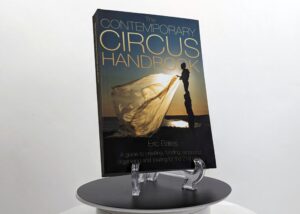
The Contemporary Circus Handbook: A Guide to Creating, Funding, Producing, Organizing and Touring for the 21st Century is a guide to creating theatrical performance shows, built on interviews with dozens of creators who have made shows—big and small—throughout their careers. The author’s circus background is used as an example of practical steps for any performing artist to navigate: from applying for funding, building a team, planning workshops and residencies, and includes many compelling examples of the characteristics of successful shows. These lessons are applicable to circus, dance and theater, as well as most performing arts.
Contortion and Practices of Body Flexibility in East Asia: Mongolia, China, Japan – Mariam Ala-Rashi (link)
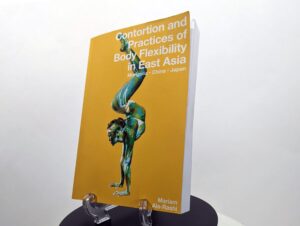
This compendium comprises three individual research studies that examine contortion and practices of body flexibility in East Asia, namely China, Mongolia, and Japan. It explores the performance art forms of Chinese contortion; Mongolian contortion; and the Kakubei Jishi lion dance of the Niigata prefecture in Japan, which utilizes body flexibility. Common points of discussion in these research studies are the investigation of the history and genesis of these art forms and how they developed in various political and social dynamics. This work further offers vast knowledge about crucial elements such as the artist’s training processes, their training environment, the development of aesthetics, symbolism in costuming and body movements, religious themes, mythology and natural phenomena, and costume designs. This compendium includes data from a wide range of literature, material evidence, oral history, and current media reports, and considers recent work in anthropology, archaeology, and political history. It, therefore, offers the interested reader, the scholar, and the contortionist and contortion practitioner a substantial treatise about contortionism and practices of body flexibility.
Opulence & Ostentation: Building the Circus – Steve Ward (link)
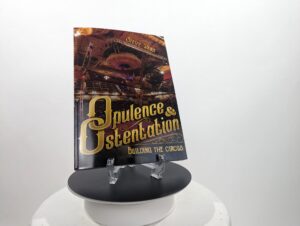
Since the foundation of the ‘modern’ circus in the eighteenth century, the circus has been presented in defined spaces. Initially, performances were given in the open air and, over a period of time, these spaces first became enclosed and then later roofed. Temporary wooden structures often became semi-permanent until, in the nineteenth century, many permanent stone-built buildings were erected solely for the purpose of presenting circus. This phenomenon spread from the UK across Europe and beyond, creating a style of circus architecture that has never been repeated. The purpose of this book is to examine what caused these buildings to be constructed and their design and architecture. Examples of key structures will be explored in detail, some of them still surviving today and still being used for circus performances. The book will also look at the developments of contemporary circus architecture and raise questions as to the future of the circus building.
All image rights to Thom Wall....
Do you have a story to share? Submit your news story, article or press release.


